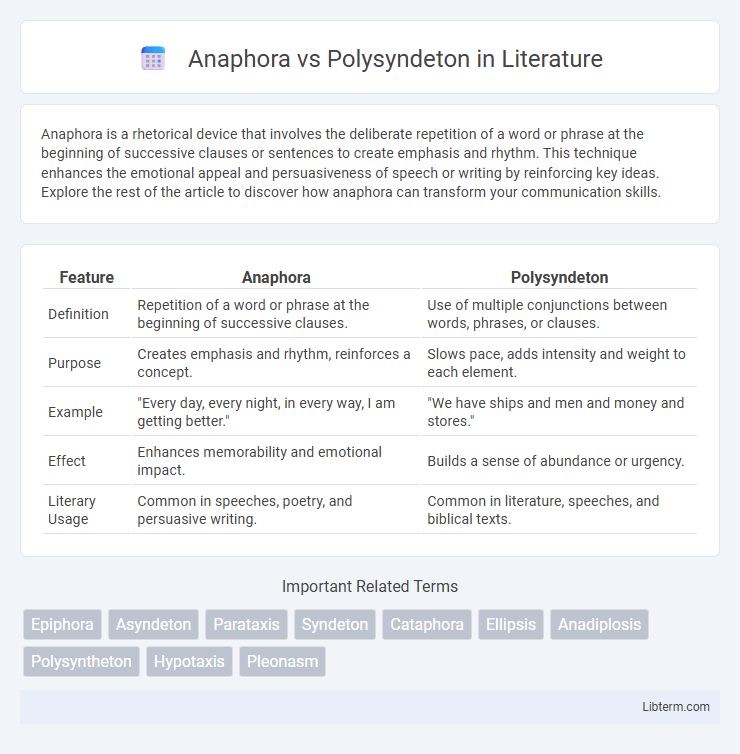Anaphora is a rhetorical device that involves the deliberate repetition of a word or phrase at the beginning of successive clauses or sentences to create emphasis and rhythm. This technique enhances the emotional appeal and persuasiveness of speech or writing by reinforcing key ideas. Explore the rest of the article to discover how anaphora can transform your communication skills.
Table of Comparison
| Feature | Anaphora | Polysyndeton |
|---|---|---|
| Definition | Repetition of a word or phrase at the beginning of successive clauses. | Use of multiple conjunctions between words, phrases, or clauses. |
| Purpose | Creates emphasis and rhythm, reinforces a concept. | Slows pace, adds intensity and weight to each element. |
| Example | "Every day, every night, in every way, I am getting better." | "We have ships and men and money and stores." |
| Effect | Enhances memorability and emotional impact. | Builds a sense of abundance or urgency. |
| Literary Usage | Common in speeches, poetry, and persuasive writing. | Common in literature, speeches, and biblical texts. |
Introduction to Anaphora and Polysyndeton
Anaphora is a rhetorical device characterized by the deliberate repetition of a word or phrase at the beginning of successive clauses or sentences to create emphasis and rhythm. Polysyndeton involves the intentional use of multiple conjunctions between words, phrases, or clauses, enhancing the sense of abundance and complexity. Both techniques are employed in literature and speeches to influence tone, pace, and emotional impact.
Defining Anaphora: Meaning and Usage
Anaphora is a rhetorical device that involves the intentional repetition of a word or phrase at the beginning of successive clauses or sentences, enhancing emphasis and emotional effect. Commonly used in poetry, speeches, and persuasive writing, anaphora creates rhythm and reinforces key ideas to engage audiences. Unlike polysyndeton, which emphasizes repetition of conjunctions, anaphora centers on repetitive initial wording to strengthen thematic messages.
Understanding Polysyndeton: Definition and Effects
Polysyndeton is a rhetorical device characterized by the deliberate use of multiple conjunctions between words, phrases, or clauses, enhancing the rhythm and pace of a sentence. This technique emphasizes each element individually, creating a sense of abundance or overwhelming detail, often evoking emotional intensity or a dramatic effect. Understanding polysyndeton reveals its power to slow down the reading experience, magnify the importance of each item, and inject a sense of urgency or continuity in literary and persuasive contexts.
Historical Origins of Anaphora and Polysyndeton
Anaphora, rooted in ancient Greek rhetoric, was widely used by classical orators such as Demosthenes to emphasize key points through repetition at the beginnings of successive clauses. Polysyndeton traces its origins to ancient Hebrew poetry and biblical texts, where the extensive use of conjunctions like "and" created a rhythmic and cumulative effect. Both devices have endured centuries as powerful tools in literature and speech, evolving across cultures and languages while maintaining their distinct historical significance.
Structural Differences between Anaphora and Polysyndeton
Anaphora involves the deliberate repetition of a word or phrase at the beginning of successive clauses to create emphasis and rhythm, enhancing the emotional impact of the text. Polysyndeton features the repeated use of conjunctions, such as "and" or "or," between words or clauses, slowing the pace and adding a sense of abundance or intensity. Structurally, anaphora is concerned with repeated openings, while polysyndeton emphasizes multiple conjunctions within a sentence to influence the flow and tone.
Rhetorical Purposes of Anaphora
Anaphora, a rhetorical device involving the deliberate repetition of a word or phrase at the beginning of successive clauses, enhances emphasis and creates a rhythmic effect that reinforces the central message. This technique amplifies emotional appeal, aids in persuasiveness, and facilitates audience engagement by highlighting key concepts. Unlike polysyndeton, which uses multiple conjunctions for a cumulative impact, anaphora's primary purpose is to establish a memorable and cohesive argument through repetition.
Stylistic Functions of Polysyndeton
Polysyndeton enhances textual rhythm and amplifies emotional intensity by deliberately repeating conjunctions between phrases or clauses, creating a sense of persistence and accumulation. This stylistic device slows the reading pace, allowing readers to absorb each element fully, which intensifies the dramatic or rhetorical effect. Unlike anaphora, which emphasizes repetition at the beginning of clauses, polysyndeton's continuous conjunction use strengthens cohesion and amplifies the weight of each listed item.
Examples of Anaphora in Literature and Speech
Anaphora is a rhetorical device involving the repetition of a word or phrase at the beginning of successive clauses, famously used in Martin Luther King Jr.'s "I Have a Dream" speech for emotional impact. Examples in literature include Charles Dickens' *A Tale of Two Cities*, where the phrase "It was the best of times, it was the worst of times" emphasizes contrasting themes. This technique creates rhythm and reinforces central ideas by anchoring key phrases in the audience's mind.
Notable Uses of Polysyndeton in Writing
Polysyndeton enhances the rhythm and emphasis in writing by deliberately using multiple conjunctions to connect words or phrases, as famously employed in the Bible's King James Version, such as "and every living substance was destroyed." Shakespeare utilized polysyndeton in plays like Macbeth to build tension and urgency through repetitive "and" usage. Modern authors, including Ernest Hemingway, apply polysyndeton to create a staccato effect that intensifies narrative pacing and emotional impact.
Comparing the Impact: Anaphora vs. Polysyndeton
Anaphora creates rhythm and emphasis through the repetition of a word or phrase at the beginning of successive clauses, enhancing emotional intensity and memorability. Polysyndeton uses multiple conjunctions in close succession to slow down the pace and build a sense of abundance or overwhelm, amplifying the complexity of the message. While anaphora emphasizes unity and focus, polysyndeton highlights quantity and elaboration, making their impacts distinct yet complementary in rhetorical effect.
Anaphora Infographic

 libterm.com
libterm.com